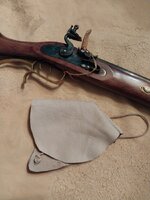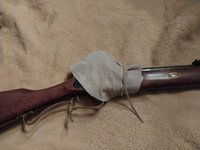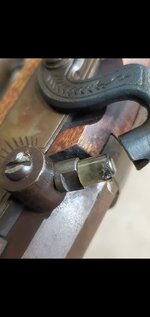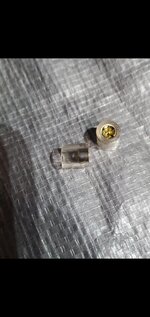 Items needed:
Items needed:
Scissors
Teflon Tape (Plumbers Tape)
Nipple Wrench
Ear Plug
About four years ago, I was testing a powder called American Pioneer. It is a sugar based powder (Pop the lid and it smells like brown sugar!) and the subject popped up on a forum I am a member on.
Condensation / Barrel Sweat: What do you do?
A lot of folks said once their muzzleloader is loaded, they leave it out in the barn or in their truck where the temperature is consistent rather than introduce their muzzleloader from Hot to Cold and vice versa.
If you hunt during the cold weather seasons, You obviously have taken your muzzleloader out into the cold for hours and then took it back inside the warm house once the hunt was over. I know I do, and at times, a thin layer of condensation would build up in the bore and exterior of the rifle, causing rust spotting if I did not wipe it down with a towel.
While testing that American Pioneer Powder, I had loaded a test barrel (Blued Percussion barrel) and found that if left outside in the cold for a few hours and brought back inside during the night, a very light layer of condensation would form, a great deal of it, around the base of the nipple.
After a week of testing ( Our season lasts 9 days in Colorado ) I pulled the nipple and was blown away at seeing the loose powder, was now a solid block of powder! Enough moisture had slowly got into the charge and melted the powder and as it dried, it made a perfectly formed "pellet" inside of the bore and the Drum!
I decided to see what would happen if I fired it. I honestly figured I'd be pulling the ball out. I capped the rifle (Rifle was tied into a Caldwell Lead Sled) set the trigger and pulled the rope. BOOM! Instant ignition and the ball hit its mark at 50 yards!
Once more I re-tested this and again, loose powder that was formed into a pellet by the weeks end.
I figured maybe the moisture was coming in from the nipple hole and so I gutted out a #11 percussion cap and once more, tested it again. Same result after a week!
After sitting down and looking at the barrel, I just took notice to how much moisture there was, at the base of the nipple where it bottomed out at the Bolster/Drum. Could moisture/condensation really seep into the nipple threads?
I grabbed a spool of White Plumbers Tape, cut a 1" long section, cut it in half length wise and wrapped the nipple threads twice and screwed it back into the barrel, loaded the barrel and again, tested it for a week. I saved the extra side of tape for later use.

After the week test was done, I removed the nipple and found that the powder was in perfect condition and had not turned into a solid mass! Finally I had found where the moisture was seeping in through and wetting my powder charge.
If your rifle is equipped with a clean out screw, it's a good idea to remove it and add a shorter piece of teflon tape to ensure that screw is properly sealed.
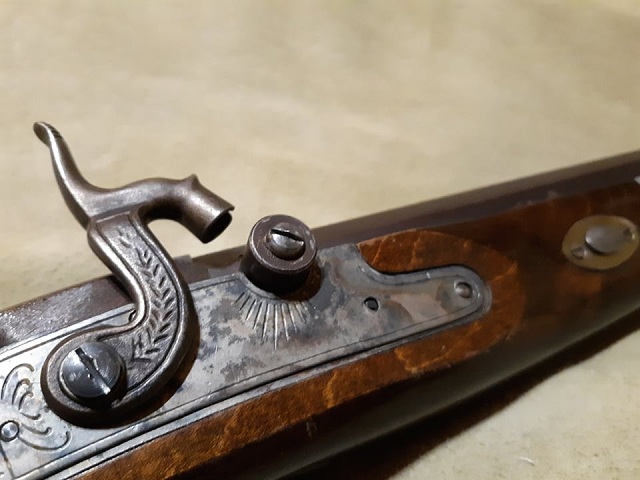 To top it off, what do we do to help keep moisture out of the main flash channel of the nipple while the Percussion Cap is NOT in place?
To top it off, what do we do to help keep moisture out of the main flash channel of the nipple while the Percussion Cap is NOT in place?
I developed and designed a hard, yet flexible, plastic Weather Guard that simply squeezed over the nipple, creating a weather tight, waterproof seal, that keeps moisture from entering through the nipple. I was checked twice by game wardens while traveling, and they immediately saw the bright pink Weather Guard and knew it was not capped.
An old ear plug also works well!

I am not a hunter that likes to pull a charge or fire off the charge at the end of the hunt. There just simply is no need to do such a thing if you are doing your part and taking care of the rifle while in the field!
I take great care in keeping moisture out by using Plumbers tape and the Weather Guard, and have not had a hang fire once in the field since switching away from greased nipples during hunting season. And Yes, I do use the synthetic powder, now and then,in my sidelock muzzleloaders which is even more prone to sucking up moisture our of the air, than regular black powder.
Every time I pull the percussion cap off and stick my rifle back into my carrying case, that Weather Guard, goes right over the nipple and the hammer is let down! While ATV'ing, its not uncommon to hit puddles or even run into weather that likes to sprinkle and make everything nice and soggy. When I get back to camp, I know that nipple is covered, and can either go inside the camper, or the truck for the night, and still be safe by mornings hunt.
I do NOT like to use grease/wax or anything that can melt on my nipple/clean out screw threads!
Think about it.... Have you ever taken a stack of shooting patches lubed with that yellow stuff, stick them into the patch box on your rifle and after an hour, have it running down the side of your stock because its melting?
Why would you do the same thing by putting grease on the threads of your nipple, and then go off hunting in the wild, during the heat of the day? It's going to run once it warms up, and can ruin that one and only shot, when you need it most. Not to mention the powder will stick to any excess grease that squeezes out, and could cause the flash hole to plug up with a granule of powder that's grease soaked.
Before loading my rifle, I always run a dry patch down the bore and then one lightly sprayed down with a product made by Birchwood Casey, called Gun Scrubber. Gun Scrubber is a great product that removes grease and oils from the inside or outside of the barrel. Think of is as a gentle brake cleaner that dries very quickly and removes every bit of grease/oil it comes across. Once I lightly spray a patch down, I then swab the bore, allow a few minutes and load up for the hunt.
This is also a great product to use after cleaning your rifle to remove water from the bolster/drum/breech plug. We try to keep oils and lubes away from these areas as they can be hard to clean if it builds up over time, so this is a great way to properly remove all moisture from these areas.
The best part about using the plumbers tape is that is stays in place! You don't have to remove the clean out screw every time you break the rifle down for its normal cleaning after your previous range session. I've done many tests in this department and I only remove this screw every 10 clean sessions and replace the plumbers tape. It keeps fouling OUT of the threads and prevents moisture from seeping in!
Give this a try on your next hunt and you WILL see a difference in your rifles ignition performance!






